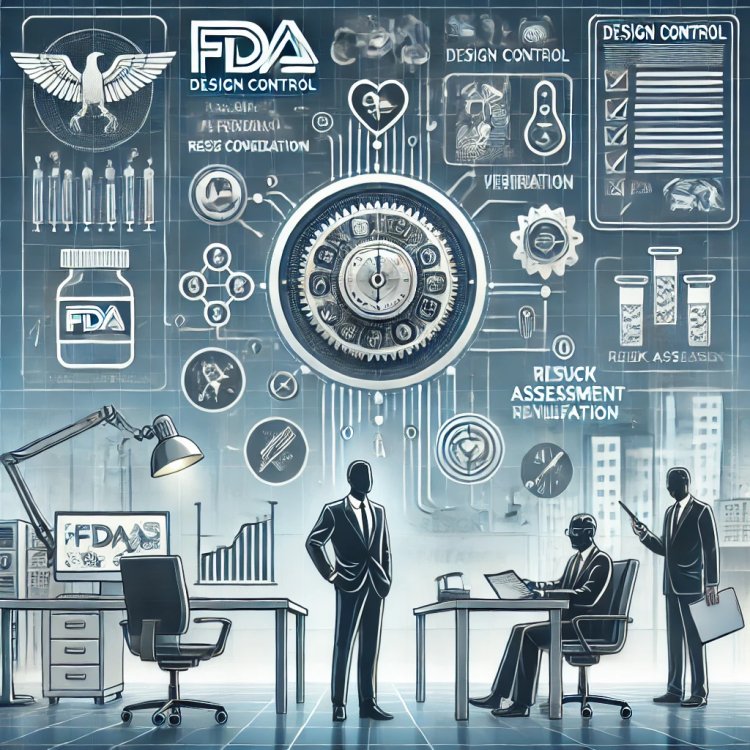Integrating Risk Management with FDA Design Control for Better Compliance
Discover how integrating risk management with FDA design control enhances compliance and improves product safety in medical device development. This approach not only aligns with regulatory standards but also fosters a proactive culture of quality, ensuring better outcomes and reduced risks throughout the product lifecycle.
Share this Post to earn Money ( Upto ₹100 per 1000 Views )

The intersection of risk management and FDA design control is critical for organizations in the medical device and pharmaceutical industries. Effective integration of these elements not only ensures compliance with regulatory standards but also enhances the quality and safety of products. This blog will provide a comprehensive guide on how to integrate risk management with FDA Design Control, outlining best practices, key considerations, and the benefits of a cohesive approach.
1. Understanding FDA Design Control
1.1 What is FDA Design Control?
FDA design control refers to a systematic approach mandated by the FDA that encompasses the planning, execution, and documentation of the design and development process for medical devices. It aims to ensure that products meet user needs and regulatory requirements while minimizing risks associated with their use.
1.2 Importance of FDA Design Control
Implementing effective FDA design control is essential for achieving regulatory compliance. It helps organizations identify potential issues early in the development process, reducing the likelihood of costly recalls or redesigns later on. Furthermore, it instills confidence in stakeholders, including customers and regulatory bodies.
2. The Role of Risk Management in Design Control
2.1 What is Risk Management?
Risk Management involves identifying, assessing, and mitigating risks that could adversely affect the quality and safety of products. In the context of medical devices, it is crucial for ensuring that potential hazards are recognized and addressed throughout the design and development process.
2.2 Why Integrate Risk Management with Design Control?
Integrating risk management with FDA design control enhances the overall quality assurance framework. By aligning these processes, organizations can proactively address potential risks, leading to improved product quality and compliance. This integration helps in building a comprehensive understanding of how design decisions impact patient safety and product effectiveness.
3. Key Steps in Integrating Risk Management with FDA Design Control
3.1 Identify Regulatory Requirements
Before initiating the integration process, organizations must thoroughly understand the regulatory requirements associated with both FDA design control and risk management. This involves reviewing relevant regulations, standards, and guidance documents.
3.2 Conduct a Risk Assessment
A comprehensive risk assessment should be conducted at the outset of the design process. This assessment should identify potential hazards, evaluate their impact, and determine the likelihood of their occurrence. Utilizing tools such as Failure Mode and Effects Analysis (FMEA) can facilitate this process.
3.3 Develop a Risk Management Plan
Once risks are identified, organizations should develop a detailed risk management plan. This plan should outline strategies for mitigating identified risks, assigning responsibilities, and establishing timelines for implementation.
4. Implementing Risk Mitigation Strategies
4.1 Design Reviews
Regular design reviews are a vital component of both design control and risk management. These reviews should assess whether risk mitigation strategies are effectively implemented and whether design changes introduce new risks.
4.2 Documentation and Change Control
Thorough documentation is crucial for demonstrating compliance with FDA design control requirements. All risk management activities, including assessments, decisions, and changes, should be meticulously documented. Change control processes must also be in place to evaluate the impact of design changes on risk profiles.
5. Quality Assurance Integration
5.1 Establishing Quality Assurance Protocols
Quality Assurance plays a pivotal role in ensuring that both risk management and design control processes are adhered to. Organizations should establish quality assurance protocols that encompass all phases of product development, from design to post-market surveillance.
5.2 Continuous Monitoring and Improvement
Implementing a continuous monitoring process is essential for assessing the effectiveness of integrated risk management and design control practices. Organizations should regularly review and update their risk management plans to reflect new information, technological advancements, and regulatory changes.
6. Benefits of Integration
6.1 Enhanced Compliance
Integrating risk management with FDA design control significantly improves compliance with regulatory requirements. By proactively addressing potential risks, organizations can avoid costly penalties and product recalls.
6.2 Improved Product Quality
A cohesive approach to risk management and Design Control leads to higher product quality. By identifying and mitigating risks early in the design process, organizations can enhance the safety and effectiveness of their medical devices.
6.3 Increased Stakeholder Confidence
Demonstrating a robust integration of risk management and design control fosters confidence among stakeholders, including customers, regulatory bodies, and investors. This increased trust can lead to enhanced market reputation and business growth.
7. Challenges and Considerations
7.1 Organizational Culture
Successfully integrating risk management with FDA design control requires a shift in organizational culture. Employees must be trained to understand the importance of both processes and encouraged to collaborate across departments.
7.2 Resource Allocation
Implementing an integrated approach may require additional resources, including personnel, training, and technology. Organizations must carefully evaluate their resource allocation to ensure effective integration.
Conclusion
In conclusion, the integration of risk management with FDA design control is essential for organizations in the medical device industry. By aligning these processes, companies can enhance compliance, improve product quality, and foster stakeholder confidence.
ComplianceQuest Management Software is crucial for organizations looking to streamline their quality management practices in 2024. By providing comprehensive tools for managing both risk and design control processes, ComplianceQuest empowers organizations to navigate regulatory complexities effectively.
Implementing a robust integration of risk management and FDA design control will ultimately contribute to safer, more effective medical devices that meet the needs of patients and healthcare providers alike. Embracing this integrated approach is not just a regulatory requirement but a strategic advantage in the competitive landscape of the healthcare industry.














